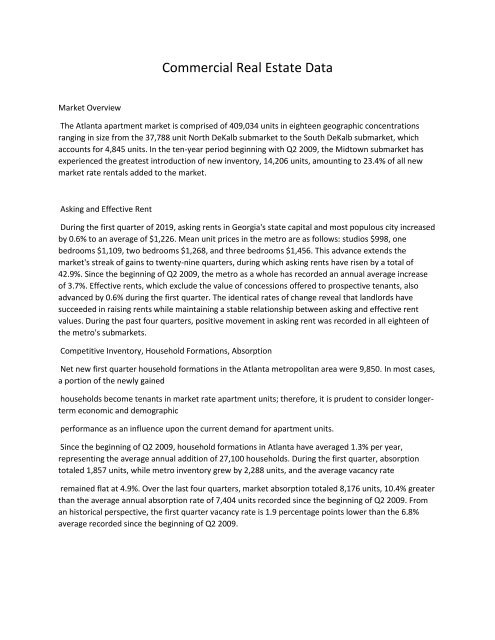Commercial Real Estate Data
Create successful ePaper yourself
Turn your PDF publications into a flip-book with our unique Google optimized e-Paper software.
<strong>Commercial</strong> <strong>Real</strong> <strong>Estate</strong> <strong>Data</strong><br />
Market Overview<br />
The Atlanta apartment market is comprised of 409,034 units in eighteen geographic concentrations<br />
ranging in size from the 37,788 unit North DeKalb submarket to the South DeKalb submarket, which<br />
accounts for 4,845 units. In the ten-year period beginning with Q2 2009, the Midtown submarket has<br />
experienced the greatest introduction of new inventory, 14,206 units, amounting to 23.4% of all new<br />
market rate rentals added to the market.<br />
Asking and Effective Rent<br />
During the first quarter of 2019, asking rents in Georgia's state capital and most populous city increased<br />
by 0.6% to an average of $1,226. Mean unit prices in the metro are as follows: studios $998, one<br />
bedrooms $1,109, two bedrooms $1,268, and three bedrooms $1,456. This advance extends the<br />
market's streak of gains to twenty-nine quarters, during which asking rents have risen by a total of<br />
42.9%. Since the beginning of Q2 2009, the metro as a whole has recorded an annual average increase<br />
of 3.7%. Effective rents, which exclude the value of concessions offered to prospective tenants, also<br />
advanced by 0.6% during the first quarter. The identical rates of change reveal that landlords have<br />
succeeded in raising rents while maintaining a stable relationship between asking and effective rent<br />
values. During the past four quarters, positive movement in asking rent was recorded in all eighteen of<br />
the metro's submarkets.<br />
Competitive Inventory, Household Formations, Absorption<br />
Net new first quarter household formations in the Atlanta metropolitan area were 9,850. In most cases,<br />
a portion of the newly gained<br />
households become tenants in market rate apartment units; therefore, it is prudent to consider longerterm<br />
economic and demographic<br />
performance as an influence upon the current demand for apartment units.<br />
Since the beginning of Q2 2009, household formations in Atlanta have averaged 1.3% per year,<br />
representing the average annual addition of 27,100 households. During the first quarter, absorption<br />
totaled 1,857 units, while metro inventory grew by 2,288 units, and the average vacancy rate<br />
remained flat at 4.9%. Over the last four quarters, market absorption totaled 8,176 units, 10.4% greater<br />
than the average annual absorption rate of 7,404 units recorded since the beginning of Q2 2009. From<br />
an historical perspective, the first quarter vacancy rate is 1.9 percentage points lower than the 6.8%<br />
average recorded since the beginning of Q2 2009.
Outlook<br />
Between now and year's end, 7,782 units of competitive apartment stock will be introduced to the<br />
metro, and Reis estimates that net total absorption will be positive 6,166 units.<br />
As a result, the vacancy rate will drift upward by 0.3 percentage points to 5.2%. Construction activity is<br />
expected to continue during each of the following two years, during which a total of 9,497 units is<br />
projected to be introduced to the market. Net new household formations at the metro level during 2020<br />
and 2021 are anticipated to average 2.0% annually, enough to facilitate an absorption rate averaging<br />
3,820 units per year.<br />
Because this amount does not exceed the forecasted new construction, the market vacancy rate will<br />
rise by 30 basis points to finish 2021 at 5.5%.<br />
Between now and year-end 2019 asking rents are expected to climb 4.2% to a level of $1,278, while<br />
effective rents will rise by 4.3% to $1,200. On an annualized basis, asking and effective rents are<br />
projected to advance at a rate of 3.1% through year end 2021, reaching average rates of $1,359 and<br />
$1,275 per unit, respectively.<br />
Reis provides commercial real estate market information and analytical tools to real estate professionals<br />
through its Reis Services subsidiary. Reis Services, including its predecessors, was founded in 1980. Reis<br />
maintains a proprietary database containing detailed information on commercial properties in<br />
metropolitan markets and neighborhoods throughout the U.S. The database contains information on<br />
apartment, office, retail, warehouse/distribution, flex/research & development, self storage, seniors<br />
housing properties and affordable housing, and is used by real estate investors, lenders and other<br />
professionals to make informed buying, selling and financing decisions. In addition, Reis data is used by<br />
debt and equity investors to assess, quantify and manage the risks of default and loss associated with<br />
individual mortgages, properties, portfolios and real estate backed securities. Reis currently provides its<br />
information services to many of the nation's leading lending institutions, equity investors, brokers and<br />
appraisers.<br />
commercial property information<br />
real estate data analysis<br />
commercial real estate market data<br />
commercial real estate data sources<br />
real estate data services<br />
commercial real estate data


















